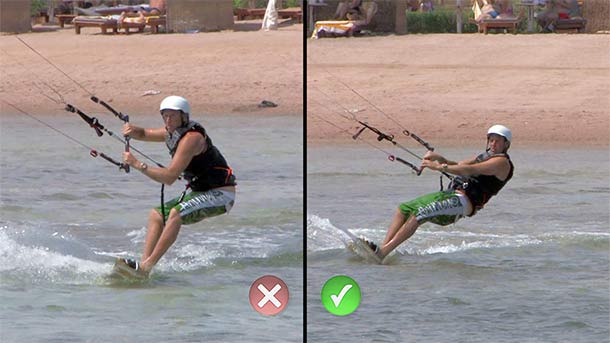How do you move from your first runs, riding along with the kite being in control of you rather than the other way round? The board bouncing around underneath you like a bucking broncho!
I’ve been in Brazil for the last couple of weeks staying at the Windtown hotel & kite school and having been back surround by newbies, leaving to master these frustrating first steps, it got me thinking once again about the one thing that will make the most difference to getting a wobbly kiter in control of her kite and board. I made a couple of suggestions to some of these new kiters and one answer, in particular, proved to be a turning point for all of them…
The Answer: Getting your shoulders back, hips forward.
But lets backtrack slightly.
What are you currently doing?
You are effectively balancing on the board during your first runs, getting used to flying the kite, understanding where it generates power and where you lose it. Getting a feeling for the board under your feet. But basically, you are performing a fine balancing act keeping yourselves moving forward whilst standing precariously on the board!
What do you want to do?
You want to get the weight off the board, this will stop you from having to balance on the board. You get your weight off by transferring it onto the kite, this will free your legs and feet, allowing them to act like suspension, rolling over the uneven surface of the water.
So you need your weight back against the kite – instinctively beginners try and sit down against the kite but this puts your body in a locked, restricted position.

You want your hips forward, and your body lending back against the kite and you initiate it by pushing your shoulders back.
When do we do this?
You need to get up, generate lots of power from the kite, to accelerate downwind like you normally do. Once you have speed and your kite is either parked at 10:30 / 1:30 / 45 degrees or flying in small subtle movements at the front of the window, push your shoulders back, your hips will then naturally come forwards, transferring your weight through your harness to your kite, and you’ll find the board become less heavy and cumbersome underneath you.
Watch this short excerpt from the full 30 minute Riding and Staying Upwind chapter, taken from the Progression Kiteboarding Beginner Collection / DVD – to see a few of these points in action:
It’s a simple movement but one that can make all the difference when you want to take control of your kite and board rather than them being in control of you!
Once you have mastered this stance you’ll find that the act of slowing down and stopping, riding in lighter winds, handling being over powered and the all-important sliding turn will suddenly make far more sense and be within your grasp.